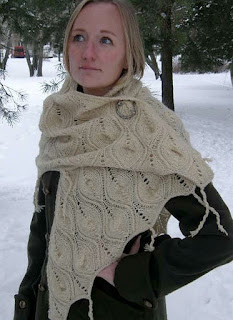Minu käest on küsitud, kuidas kududa ülevalt alla pitsimustriga varrukas. Nüüd näitan konkreetsete skeemidega. Üldjoontes on reegild sellised: eeldades, et n-ö vest on olemas, käeaugu ülemises kolmandikus korjatakse üle silmused, kootakse läbi, rea lõpus korjatakse üles uus silmus, kootakse rea lõpuni, siis jälle korjatakse üles üks silmus jms. Kui jõuab käeaugu sirge osani (kaenla all), siis võib kõik ülejäänud silmused korraga üles korjata ja edasi kududa ringselt. Olen ise n-ö "leiutanud" selle triki, et hiljem avastada, et nõnda soovitab Barbara Walker ja võimalik, et veel mitmed kudujad. Aga see selleks. Küsimus on, mida teha, kui kudum on pitsilise mustriga?
I have been asked to explain how to knit top down set-in sleeves with a lace pattern. Now I am going to show a particular example. In general, the rules are as follows: once you have a vest, so to say, pick up stitches at the upper third of the armhole, knit them, pick up a new stitch in the end of the row, work back row, pick up a new stitch at the end etc. Once you get to the straight part (under the arm), pick up all stitches and work in the round. I have "invented" the trick only to learn later, that this is recommended by Barbara Walker and possibly other knitters. But this is not very important. The quetion is, what to do when you are knitting a garment with a lace pattern?
Võib-olla mäletavad lugejad
seda sviitrit, mis sai sügisel sokilõngast valmis kootud. All on mustriskeem.
Maybe the readers remember this sweater that was knit this Autumn from a sock yarn. Below is the lace pattern chart.
Varrukatega soovitan teha nii: enne teha skeem arvutis/ruudulisel paberil. Tundub mõistlik alustada ühest mustrikorrast pluss mõned silmused äärtel. Nt üles korjata 14 silmust, kududa pahemal poolel (tavaliselt teen seda ripskoes, aga see on maitse asi), korjata veel üks silmus. All on poolik skeem, s.o. mitte terve varrukas, vaid üks mustrikord ja järgmise mustrikorra üks rida. Rida nr 0 ongi see rida, kus tuleb kududa 14 silmust ja lõpus üles korjata 1. Uut silmust tähistab X. Skeemil on näidatud paaris- ja paaritud read. Nagu skeemil näha, üks reegel on, jämedalt öeldes, mitte sisse toppida iga hinna eest. Nt ei tasu teha õhksilmust, kui see on viimane silmus, isegi kui silmuste arv lubab.
For sleeves, I have the following advice: first, make a chart on your computer/checked paper. It seems reasonable to start with one stitch pattern repeat plus something for the edges. For instance, pick up 14 stitches right side facing you, knit them on the wrong side (I always knit this row on the wrong side but it is a matter of taste), pick up one stitch. Below you have a part of the big chart, that is, not the whole sleeve but one pattern repeat and the first row of the next repeat. The row no 0 is the row where you knit 14 stitches and pick up 1. New stitches are designated with X. The chart shows odd and even rows. As you can see, one of the rules is, to put it bluntly, do not squeese in a pattern repeat at any price. That is, don't make a yarn over if it is before picking up a new stitch, even if the number of stitches allows it.

Selle sviitriga oli nii, et korjasin silmused üles, kuni sain kokku 49 silmust (35 rida). Siis kaenla alt korjasin üles korraga 8 silmust ja kudusin ringselt. Tervet kasvatuste skeemi saab näha rubriigis Õpetused (paremal ribal), Varruka skeem. Mida teha edasi? Tavaliselt koon kaenla alt üleskorjatud silmused pahempidi või parempidi või teen väikse pitsimustri. Pärast võib nende silmuste arvelt teha kahandusi ilma, et muster kannataks.
In this particular sweater, I picked up stitches untill I had 49 stitches (35 rows). Then I picked up under the arm 8 stitches and worked in the round. If you want to see the whole chart, go to Õpetused/Patterns on the right and choose Varruka skeem/Sleeve chart. And then? Usually I purl or knit or make a little lace pattern on the stitches I picked up under the arm. Later you can make decreases at the expence of these stitches without disturbing the lace pattern.













































